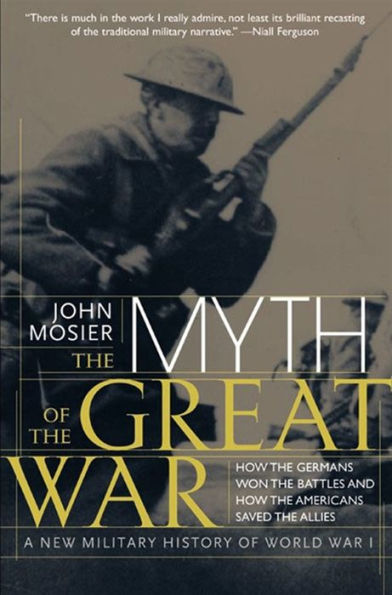Read an Excerpt
Chapter One
France and the Failures of National Defense, 1870-1914
An examination of the army before 1914 reveals that it was ruled
more by confusion than by logic, afflicted by institutional malfunctioning rather
than from the neat application of a coherent but
wrongheaded system of thought inspired by professional principles
and right-wing sentiments.... In the final analysis, the radical
Republic got the army it deserved....— Douglas Porch
The issues that determined how the Great War would be fought stemmed from the French war with Germany in 1870, the postwar responses to the defeat by the new French government, and the responses of the German Army to meet France's constantly shifting war plans. France's confused and volatile national defense policies forced the German military to adopt a set of weapons, a military doctrine, and a plan of action that determined how it would fight a future war.
On 19 July 1870, France declared war on Prussia, which immediately caused the German states allied with Prussia to declare war on France. Although France had forced the war on Prussia (something Bismarck had skillfully encouraged), and was thus the aggressor, the country had no coherent plan of action. Engels, writing in a London newspaper, pointed out that it hardly made any sense to declare war without then launching an invasion, but this is exactly what had happened .2
Three weeks after the French declaration of war, the French were still organizing at their frontier. The initial battles of early August were all fought right on the border, andmostly inside France: Wissembourg (the fourth), Wörth (the sixth), and Spicheren (the sixth). The French Army of the Northeast, defeated in all three engagements, retired in the direction of Châlons, a city located on the Marne River to the southeast of Reims. On the fifteenth, the French Army of the Center, based around Metz, was defeated at Vionville, and then, on the eighteenth, at Gravelotte, both small towns to the west of Metz.
The surviving French regrouped in Metz, waiting to be relieved. When the Germans defeated the relief forces on the thirtieth (at Beaumont), MacMahon left Bazaine to hold out in Metz, and withdrew to Sedan. There, in September 1870, he was wounded at the start of what both sides hoped would be the decisive battle of the war. Unlike Metz, Sedan is a city located in a bowl. Troops penned up there were helpless. The next day the emperor, Napoleon 111, was forced to surrender, along with most of what was left of France's army.
Broadly put, after 1870, France had three aims: to develop the capability to mount an effective defense of the frontier, to strengthen France militarily through alliances, and to develop a loyal and effective military. The initial effort was impressive. The first military planners of the Third Republic, of whom the military engineer Raymond-Adolphe Séré de Riviéres was the most important, sought to build a coherent policy of national defense for the new post-1870 frontier. Séré de Riviéres, who from 1872 to 1880 was France's minister of war, laid down the basic plans that would determine France's defense policy- a belt of fortifications that would protect the country from an invasion and allow France time to bring its armies onto the field. Over the next thirty years, starting with an appropriation of the then staggering sum of eighty-eight million francs in 1874, France poured an unprecedented amount of its resources into this project.' By 1914 there were over one hundred independent forts on the northeastern frontier alone, and the Belgians, under the direction of another brilliant engineering officer, Brialmont, had mounted a parallel effort that they felt would ensure their neutrality in the event of a future conflict: the three most strategically important Belgian cities (Namur, Liége, and Antwerp) were encircled by no less than forty forts.
The main forts were supplemented by dozens of small reinforced structures, called fortins or ouvrages, and carefully sited so as to dominate the terrain. The French encircled key cities that lay at critical transportation junctures with fortifications. From north to southeast, the cities of Lille, Maubeuge, Reims, Verdun, Toul, Épinal, and Belfort were, like the three Belgian cities, turned into what the French termed Places fortifiées, or fortified positions. A town like Verdun was the unfortified administrative center of a two-hundred-square-kilometer area protected by some twenty major forts and about twice that many smaller ouvrages.
The most important path into France lay along the Meuse River, which began in the Vosges Mountains down by Switzerland and ran up through France and Belgium into Holland. Major rail and road links ran alongside, and the river itself, with its connecting canals, was an important transportation artery. In Belgium, the fortified areas surrounding Liége and Namur sat astride the Meuse, as did Verdun. But from Verdun on down the river there were no fewer than twelve isolated forts on the heights of the Meuse, guarding the major crossings.
In addition, there were fortified towns and single forts stretching along the Belgian frontier from Lille to the new German frontier, and along that frontier down to Switzerland. The scheme of fortifications gave the Germans difficult choices. From the easternmost fort of Reims (Pompelle) to the westernmost fort of Verdun (Bois Bourrus) was only about forty kilometers, most of which was taken up by the Argonne Forest, a rough and dense tract of the sort European armies had traditionally avoided.
Below Verdun, there was another stretch between the river forts along the Meuse and the Moselle. But the French considered this area, the plain of the Woëvre, a swamp as unsuitable for maneuver as the Argonne. And from Épinal on down to Belfort, the forts formed a dense barrier. An invader (which could only be Germany) would either have to...



